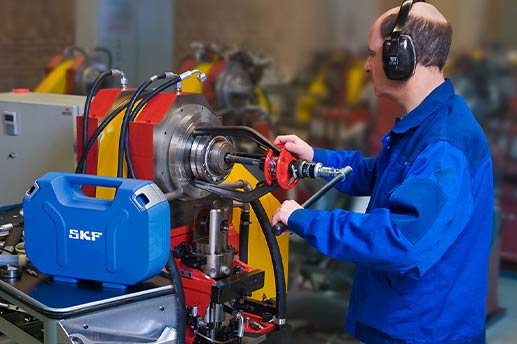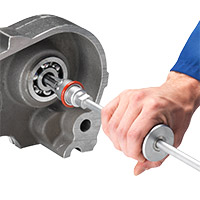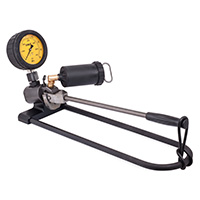How to Remove a Bearing

When it comes to how to remove a bearing, there are many different methods that are used across industry. These include using a bearing puller, hydraulic methods, oil, steam and brute force. Whilst some methods are best practice, others can lead to your machinery becoming damaged, or even result in personal injury, so it's essential that you know which is the best bearing removal method for your application.
In this article, we'll talk you through the different methods available for bearing removal, as well as giving you some top tips for removing a bearing, helping to extend the life of your machinery.
Bearing Removal Methods
There are many different bearing removal methods, and the right method will depend on the individual application and the equipment that you have available, as well as your personal preferences. Let's take a look at some of the most common methods of bearing removal, along with the pros and cons of each method.
Bearing Puller
 Removing a bearing using a bearing puller is often seen as the best and most reliable way to remove a bearing from a shaft. This method involves using a set of jaws that are specifically designed to fit around the bearing, before pulling the bearing from the shaft. Bearing pullers are available in both mechanical and hydraulic options.
Removing a bearing using a bearing puller is often seen as the best and most reliable way to remove a bearing from a shaft. This method involves using a set of jaws that are specifically designed to fit around the bearing, before pulling the bearing from the shaft. Bearing pullers are available in both mechanical and hydraulic options.
One of the key benefits of using a bearing puller is that it minimises the risk of damage to your machinery. In addition, this method can be used on a wide range of bearings, regardless of their size or shape. However, using a puller is not suitable for larger, heavier bearings which cannot be easily lifted.
Hydraulic Methods
Another method for removing bearings is by using hydraulics. You can choose between using a hydraulic nut or a hydraulic pump and oil injector. Hydraulics are often the method of choice for larger, heavy bearings, that would be difficult to remove with a bearing puller.
 Using hydraulics to remove a bearing allows for greater control. This means that you can be more precise during the removal of the bearing, helping to reduce the risk of damaging the shaft or personal injury occurring. There’s also less manual effort required, which is why hydraulic methods are often used to remove large bearings.
Using hydraulics to remove a bearing allows for greater control. This means that you can be more precise during the removal of the bearing, helping to reduce the risk of damaging the shaft or personal injury occurring. There’s also less manual effort required, which is why hydraulic methods are often used to remove large bearings.
Hot Oil And Steam
Using hot oil or steam to heat a bearing and facilitate removal is a method that has been used for many years. This involves heating up the oil or steam to a high temperature, which then causes the bearing to expand and release from the shaft.
Whilst this method is effective, it can also be extremely dangerous, sometimes resulting in severe burns. Not only that, but it also has the potential to damage surrounding machinery, leading to further costs for repair. For this reason, we'd always recommend avoiding using hot oil or steam to remove a bearing.
Brute Force
The final method of bearing removal is brute force. This involves using a hammer or other tool to try and pry the bearing from the shaft or housing manually. This often requires a high level of force, as the bearing is securely fastened onto the shaft.
Whilst brute force can be an effective way of removing a bearing, it often causes damage to surrounding equipment, such as the shaft and couplings, due to the extreme force required. In addition to this, it also increases the risk of personal injury - something that every business wants to avoid. So, we'd always recommend avoiding using brute force to remove a bearing.
Top Tips For Bearing Removal
If you're preparing to remove a bearing for the first time, you might be looking for tips for bearing removal. We've put together some of our top tips below, to help you get started in the best possible way.
- Always follow the manufacturer's instructions when removing a bearing, and never try to improvise.
- Before attempting to remove a bearing for the first time, it's important to undergo training with a professional. This ensures that you can work safely to remove the bearing, reducing the risk of personal injury or any damage to surrounding equipment.
- If using a puller, make sure you have the correct size and shape jaws to fit the bearing correctly.
- If using hydraulics, always use a cylinder that is specifically designed for bearings.
- Never use hot oil or steam to remove a bearing - it's dangerous and can damage your machinery.
- If you're unsure of which method is right for your machinery, contact a maintenance product specialist for advice before attempting removal.
In Summary
Bearing removal can be challenging, but understanding the right method to use for your machinery will help to give you a head start. The most important thing is to ensure that you have received comprehensive training before attempting to remove a bearing, as well as ensuring that you have the correct tools for safe removal.
We'd always recommend staying clear of outdated and unsafe methods of bearing removal, such as hot oil, steam or brute force. Instead, we'd recommend using a bearing puller or hydraulic methods to safely and effectively remove your bearing.
If you need any further information on how to remove a bearing, our bearing and maintenance product experts are always happy to help. Give us a call today to find out more.
